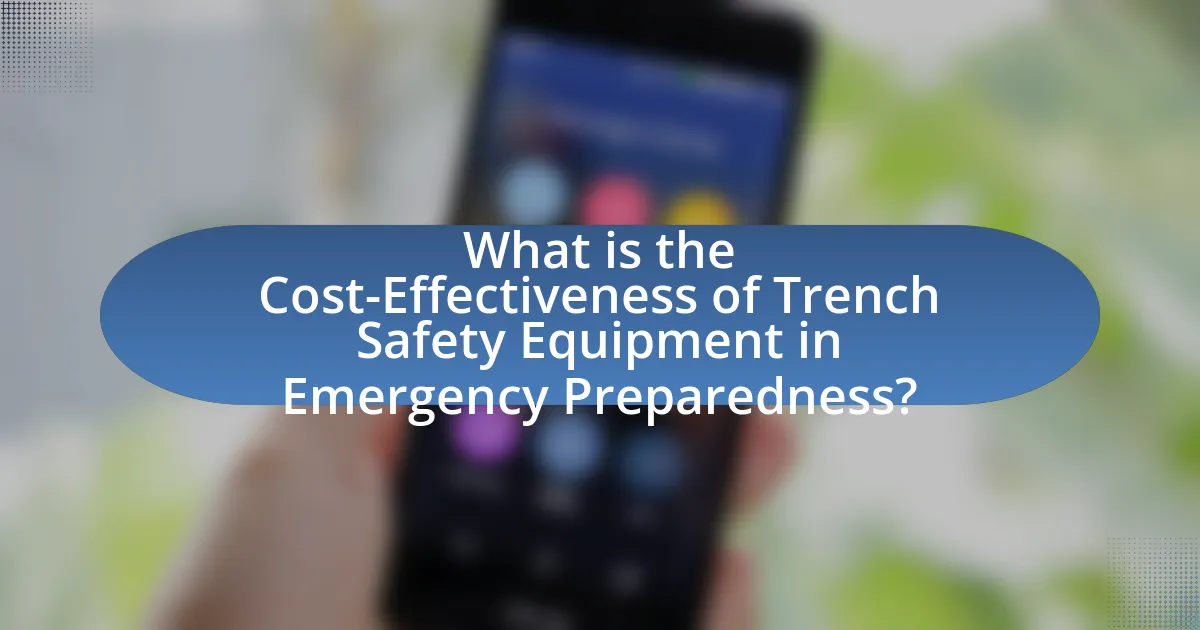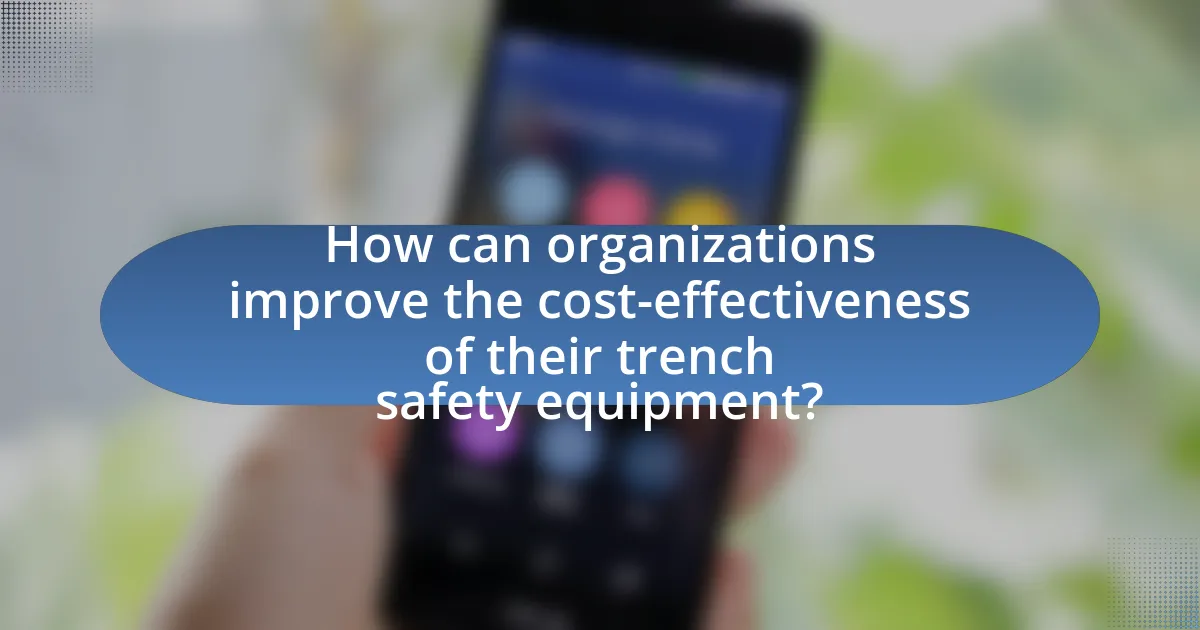The article evaluates the cost-effectiveness of trench safety equipment in emergency preparedness, emphasizing its role in reducing accidents and fatalities during excavation work. It discusses the financial implications of investing in safety measures, such as shoring systems and protective barriers, highlighting that effective safety practices can save employers significantly compared to the costs associated with accidents. Key metrics for assessing cost-effectiveness, including return on investment and incremental cost-effectiveness ratio, are outlined, along with the importance of training and maintenance in maximizing safety and compliance. The article also addresses regulatory requirements and the consequences of non-compliance, providing a comprehensive overview of the factors influencing the economic viability of trench safety equipment.

What is the Cost-Effectiveness of Trench Safety Equipment in Emergency Preparedness?
The cost-effectiveness of trench safety equipment in emergency preparedness is high, as it significantly reduces the risk of accidents and fatalities during excavation work. Investing in trench safety equipment, such as shoring systems and protective barriers, can prevent costly injuries and legal liabilities. For instance, the Occupational Safety and Health Administration (OSHA) reports that trench collapses can lead to fatalities, with an average cost of $1 million per incident when accounting for medical expenses, legal fees, and lost productivity. Therefore, the upfront investment in trench safety equipment is justified by the potential savings from avoiding these high costs associated with accidents.
How is cost-effectiveness defined in the context of trench safety equipment?
Cost-effectiveness in the context of trench safety equipment is defined as the assessment of the financial efficiency of safety measures relative to their ability to prevent accidents and injuries during trench operations. This evaluation involves comparing the costs of implementing safety equipment, such as trench boxes and shoring systems, against the potential costs associated with accidents, including medical expenses, legal fees, and lost productivity. Studies indicate that investing in proper trench safety equipment can significantly reduce the incidence of fatalities and injuries, thereby demonstrating a favorable cost-benefit ratio. For instance, the Occupational Safety and Health Administration (OSHA) reports that effective safety measures can save employers up to $4 for every $1 spent on safety equipment, highlighting the economic advantages of prioritizing trench safety.
What metrics are used to evaluate cost-effectiveness?
Cost-effectiveness is evaluated using metrics such as cost per outcome, incremental cost-effectiveness ratio (ICER), and return on investment (ROI). Cost per outcome measures the total cost associated with achieving a specific result, while ICER compares the difference in costs and outcomes between two interventions, providing a ratio that indicates the additional cost required for one more unit of benefit. ROI assesses the financial return relative to the investment made, often expressed as a percentage. These metrics are essential in determining the economic viability of trench safety equipment in emergency preparedness by quantifying the financial implications against the safety benefits achieved.
How do initial costs compare to long-term savings?
Initial costs for trench safety equipment are typically higher than long-term savings, as the upfront investment is necessary to ensure compliance with safety regulations and prevent costly accidents. For instance, investing in high-quality trench safety systems can reduce the likelihood of injuries and associated legal fees, which can average $1 million per incident. Additionally, proper safety equipment can lead to lower insurance premiums over time, further enhancing long-term savings. Studies indicate that organizations that prioritize safety equipment can save up to 50% on costs related to workplace injuries, demonstrating that initial expenditures can yield significant financial benefits in the long run.
Why is trench safety equipment essential for emergency preparedness?
Trench safety equipment is essential for emergency preparedness because it significantly reduces the risk of accidents and fatalities during excavation work. The Occupational Safety and Health Administration (OSHA) reports that trench collapses can occur within seconds, leading to serious injuries or death; therefore, implementing safety measures such as trench boxes, shoring, and proper training is crucial. These safety tools not only protect workers but also ensure compliance with safety regulations, ultimately minimizing costs associated with accidents, legal liabilities, and project delays.
What are the risks associated with trench work?
The risks associated with trench work include cave-ins, falls, hazardous atmospheres, and equipment-related accidents. Cave-ins pose the most significant risk, as they can occur suddenly and lead to serious injuries or fatalities; according to the Occupational Safety and Health Administration (OSHA), approximately 75% of trench-related fatalities result from cave-ins. Falls into trenches can also cause injuries, particularly if proper barriers or safety measures are not in place. Additionally, trenches may contain hazardous atmospheres, such as toxic gases or low oxygen levels, which can endanger workers’ health. Equipment-related accidents, including those involving heavy machinery, can further exacerbate the dangers present in trench work environments.
How does trench safety equipment mitigate these risks?
Trench safety equipment mitigates risks associated with trenching operations by providing structural support, preventing collapses, and ensuring worker safety. Equipment such as trench boxes and shoring systems stabilize the walls of trenches, reducing the likelihood of cave-ins, which are a leading cause of fatalities in excavation work. According to the Occupational Safety and Health Administration (OSHA), approximately 1 in 5 worker deaths in construction are related to trenching and excavation, highlighting the critical need for effective safety measures. Additionally, personal protective equipment (PPE) and monitoring systems enhance worker safety by alerting them to hazardous conditions, thereby minimizing the risk of injury or death.
What factors influence the cost-effectiveness of trench safety equipment?
The cost-effectiveness of trench safety equipment is influenced by factors such as initial purchase price, maintenance costs, compliance with safety regulations, and the potential for reducing injury-related expenses. The initial purchase price affects budget allocation, while maintenance costs impact long-term financial planning. Compliance with safety regulations ensures that equipment meets legal standards, potentially avoiding fines and enhancing worker safety. Additionally, reducing injury-related expenses through effective safety measures can lead to significant savings, as studies indicate that effective trench safety practices can lower accident rates by up to 50%, thereby justifying the investment in quality equipment.
How do equipment quality and durability impact costs?
Equipment quality and durability significantly impact costs by influencing both initial purchase prices and long-term maintenance expenses. High-quality, durable equipment typically incurs a higher upfront cost but reduces the frequency of repairs and replacements, leading to lower overall lifecycle costs. For instance, a study by the National Institute for Occupational Safety and Health (NIOSH) found that investing in durable trench safety equipment can decrease maintenance costs by up to 30% over five years compared to lower-quality alternatives. This demonstrates that while the initial investment may be higher, the long-term savings and enhanced safety justify the expense, ultimately making high-quality equipment more cost-effective in emergency preparedness scenarios.
What role does training play in maximizing cost-effectiveness?
Training plays a crucial role in maximizing cost-effectiveness by enhancing the skills and knowledge of personnel, which leads to improved operational efficiency and reduced errors. When workers are well-trained in the use of trench safety equipment, they are less likely to make costly mistakes that could result in accidents or equipment damage. For instance, a study by the National Institute for Occupational Safety and Health (NIOSH) found that effective training programs can reduce workplace injuries by up to 30%, thereby lowering associated costs such as medical expenses and lost productivity. This demonstrates that investing in training not only improves safety but also contributes to significant cost savings in emergency preparedness scenarios.
How can organizations assess their current trench safety equipment?
Organizations can assess their current trench safety equipment by conducting a comprehensive inventory and evaluation of all existing gear, ensuring compliance with safety regulations and standards. This assessment should include checking for wear and tear, functionality, and adherence to guidelines set by organizations such as the Occupational Safety and Health Administration (OSHA), which mandates specific safety measures for trench work. Additionally, organizations can utilize safety audits and inspections, which involve reviewing equipment performance records and gathering feedback from personnel who use the equipment regularly. This systematic approach not only identifies deficiencies but also helps in determining the cost-effectiveness of the equipment in relation to safety outcomes, thereby enhancing emergency preparedness.
What are the common challenges in evaluating trench safety equipment?
Common challenges in evaluating trench safety equipment include the variability in regulatory standards, the difficulty in assessing equipment performance under diverse soil conditions, and the lack of standardized testing protocols. Regulatory standards can differ significantly across regions, making it challenging to ensure compliance and effectiveness. Additionally, soil conditions, such as moisture content and type, can greatly affect the performance of trench safety equipment, complicating evaluations. Furthermore, the absence of universally accepted testing protocols leads to inconsistencies in performance data, hindering accurate comparisons and assessments of safety equipment.

What are the types of trench safety equipment available?
The types of trench safety equipment available include trench boxes, shoring systems, trench shields, and personal protective equipment (PPE). Trench boxes are used to protect workers from cave-ins by providing a safe working environment within the trench. Shoring systems, which can be hydraulic or mechanical, support the walls of the trench to prevent collapses. Trench shields, similar to trench boxes, are designed to protect workers but are typically lighter and easier to move. PPE, such as hard hats, safety vests, and steel-toed boots, is essential for worker safety in trenching operations. These equipment types are critical for ensuring safety and compliance with OSHA regulations, which mandate protective measures in trenching activities to prevent accidents and fatalities.
What are the primary categories of trench safety equipment?
The primary categories of trench safety equipment include protective systems, monitoring devices, and personal protective equipment (PPE). Protective systems, such as trench boxes and shoring, are designed to prevent collapses and protect workers. Monitoring devices, including gas detectors and water level indicators, ensure safe working conditions by detecting hazardous environments. Personal protective equipment, such as hard hats, gloves, and safety boots, provides individual worker safety against potential injuries. These categories are essential for maintaining safety standards in trench work, as outlined by OSHA regulations, which emphasize the importance of proper safety measures to prevent accidents and fatalities in excavation sites.
How do protective systems differ from monitoring systems?
Protective systems are designed to prevent accidents and injuries, while monitoring systems are intended to detect and report conditions or events that may lead to safety issues. Protective systems, such as trench boxes or shoring equipment, actively safeguard workers by providing physical barriers and support, thereby reducing the risk of cave-ins. In contrast, monitoring systems, like sensors or alarms, track environmental conditions and alert personnel to potential hazards, allowing for timely intervention. The distinction lies in their functions: protective systems focus on prevention through physical means, whereas monitoring systems emphasize detection and response to emerging risks.
What are the latest innovations in trench safety equipment?
The latest innovations in trench safety equipment include advanced trench boxes with integrated monitoring systems, which provide real-time data on soil conditions and structural integrity. These innovations enhance worker safety by allowing for immediate responses to potential hazards, such as soil movement or water accumulation. Additionally, the use of lightweight, modular trench shields has improved portability and ease of setup, reducing labor costs and time on site. Recent developments also feature smart sensors that can detect gas leaks and alert workers, further increasing safety measures in trench operations.
How do different types of trench safety equipment compare in cost-effectiveness?
Different types of trench safety equipment vary significantly in cost-effectiveness, with trench boxes generally offering the best balance of safety and affordability. Trench boxes, which provide protective barriers against collapses, typically cost between $1,000 and $5,000, depending on size and material, and can be reused multiple times, reducing long-term expenses. In contrast, shoring systems, while offering enhanced safety, can range from $2,000 to $10,000 and may require more frequent maintenance or replacement, increasing overall costs. Additionally, personal protective equipment (PPE) like helmets and harnesses, while essential, usually incurs lower costs, averaging around $100 to $500, but do not provide the same level of structural safety as trench boxes or shoring systems. Therefore, trench boxes are often deemed the most cost-effective option for ensuring safety in trench work, as they combine reasonable initial investment with durability and effectiveness in preventing accidents.
What are the cost implications of using shoring versus trench boxes?
Using shoring typically incurs higher costs compared to trench boxes due to the need for specialized materials and labor for installation. Shoring systems often require more extensive engineering and design, which can lead to increased upfront expenses. In contrast, trench boxes are generally more cost-effective as they are pre-manufactured, easier to install, and require less labor, resulting in lower overall project costs. For example, a study by the Occupational Safety and Health Administration (OSHA) indicates that trench boxes can reduce labor costs by up to 30% compared to shoring systems, making them a more economical choice for many construction projects.
How does the choice of materials affect overall costs?
The choice of materials significantly affects overall costs in trench safety equipment by influencing both initial purchase prices and long-term maintenance expenses. For instance, high-quality materials such as steel or reinforced composites may have a higher upfront cost but offer greater durability and safety, reducing the need for frequent replacements and repairs. Conversely, cheaper materials may lower initial costs but can lead to higher long-term expenses due to increased wear and tear, safety risks, and potential liability issues. Studies indicate that investing in durable materials can lead to a 20-30% reduction in total lifecycle costs, as they minimize the frequency of equipment failures and associated downtime.
What are the regulatory requirements for trench safety equipment?
The regulatory requirements for trench safety equipment are primarily governed by the Occupational Safety and Health Administration (OSHA) standards, specifically 29 CFR 1926 Subpart P. These regulations mandate that employers must provide protective systems for trenches deeper than five feet, which include options such as trench boxes, shoring, and sloping. Additionally, the regulations require that a competent person conduct inspections of the trench and the protective systems before work begins and as conditions change. Compliance with these standards is essential to prevent cave-ins and ensure worker safety, as cave-ins are a leading cause of fatalities in excavation work, with OSHA reporting that they account for approximately 25% of excavation-related deaths.
How do regulations impact the cost of trench safety equipment?
Regulations significantly increase the cost of trench safety equipment due to compliance requirements and safety standards. For instance, regulations from organizations such as the Occupational Safety and Health Administration (OSHA) mandate specific safety measures, which necessitate the use of higher-quality materials and advanced technology in equipment design. This compliance often leads to increased manufacturing costs, which are then passed on to consumers. According to a report by the National Institute for Occupational Safety and Health (NIOSH), adherence to safety regulations can raise equipment costs by 20% to 30% compared to non-compliant alternatives.
What are the consequences of non-compliance with safety regulations?
Non-compliance with safety regulations can lead to severe consequences, including legal penalties, financial losses, and increased risk of accidents. Organizations may face fines and sanctions imposed by regulatory bodies, which can amount to thousands or even millions of dollars depending on the severity of the violation. Additionally, non-compliance can result in increased insurance premiums and potential lawsuits from injured parties, further straining financial resources. A study by the Occupational Safety and Health Administration (OSHA) indicates that workplaces with poor safety compliance experience significantly higher rates of accidents, leading to lost productivity and increased costs associated with worker compensation claims. Thus, adhering to safety regulations is crucial for minimizing risks and protecting both employees and organizational assets.

How can organizations improve the cost-effectiveness of their trench safety equipment?
Organizations can improve the cost-effectiveness of their trench safety equipment by implementing regular maintenance schedules and investing in training programs for personnel. Regular maintenance ensures that equipment remains in optimal working condition, reducing the likelihood of costly repairs or replacements. For instance, a study by the National Institute for Occupational Safety and Health (NIOSH) indicates that proper maintenance can extend the lifespan of safety equipment by up to 30%. Additionally, training programs enhance the competency of workers, leading to fewer accidents and associated costs. According to the Occupational Safety and Health Administration (OSHA), organizations that invest in safety training can reduce workplace injuries by 20-40%, further contributing to cost savings.
What best practices should organizations follow for trench safety equipment maintenance?
Organizations should implement regular inspections, proper cleaning, and timely repairs for trench safety equipment maintenance. Regular inspections ensure that equipment meets safety standards and identifies wear or damage, which is crucial as the Occupational Safety and Health Administration (OSHA) mandates that trench safety equipment must be inspected before each use. Proper cleaning prevents the accumulation of dirt and debris that can compromise equipment functionality. Timely repairs are essential to maintain equipment integrity, as failure to address issues can lead to accidents, supported by data indicating that 70% of trench-related fatalities involve equipment failure. By adhering to these best practices, organizations can enhance safety and reduce the risk of incidents during trench operations.
How often should trench safety equipment be inspected and maintained?
Trench safety equipment should be inspected and maintained daily before use and after any significant weather events or changes in site conditions. Regular inspections ensure that equipment meets safety standards and functions properly, reducing the risk of accidents. According to OSHA regulations, specific equipment like trench boxes and shoring systems must be inspected by a competent person to identify any defects or hazards. This proactive approach not only enhances safety but also contributes to the overall cost-effectiveness of trench safety measures in emergency preparedness.
What are the signs that trench safety equipment needs replacement?
Trench safety equipment needs replacement when it shows visible signs of wear, such as cracks, rust, or deformation. These physical damages compromise the structural integrity and effectiveness of the equipment, increasing the risk of accidents. Additionally, if safety equipment fails to meet current safety standards or regulations, it should be replaced to ensure compliance and protection. Regular inspections revealing frequent failures or malfunctions also indicate that the equipment is no longer reliable and requires replacement.
What strategies can organizations implement to enhance training on trench safety equipment?
Organizations can enhance training on trench safety equipment by implementing hands-on training sessions, utilizing virtual reality simulations, and conducting regular safety drills. Hands-on training allows workers to familiarize themselves with equipment in real-world scenarios, which has been shown to improve retention of safety protocols. Virtual reality simulations provide immersive experiences that can replicate hazardous conditions without risk, thereby increasing engagement and understanding of safety measures. Regular safety drills reinforce knowledge and ensure that workers are prepared for emergencies, as studies indicate that frequent practice leads to better performance in actual situations.
How can training programs be tailored to specific organizational needs?
Training programs can be tailored to specific organizational needs by conducting a thorough needs assessment that identifies skill gaps and organizational objectives. This assessment involves analyzing current employee competencies, understanding the specific challenges faced by the organization, and aligning training content with strategic goals. For instance, a study by the Association for Talent Development found that organizations that customize training programs based on specific needs see a 25% increase in employee performance. By integrating feedback from employees and management, organizations can ensure that training is relevant and directly applicable to their operational context, thereby enhancing effectiveness and engagement.
What are the benefits of ongoing training for trench safety equipment users?
Ongoing training for trench safety equipment users significantly enhances safety and compliance in excavation work. Regular training ensures that users are updated on the latest safety protocols, equipment usage, and regulatory requirements, which reduces the risk of accidents and injuries. According to the Occupational Safety and Health Administration (OSHA), proper training can decrease trench-related fatalities by up to 50%. Additionally, ongoing training fosters a culture of safety, encouraging users to identify hazards proactively and implement effective safety measures. This continuous education ultimately leads to improved operational efficiency and cost savings by minimizing downtime and potential legal liabilities associated with safety violations.
What practical tips can organizations apply to ensure cost-effective trench safety equipment usage?
Organizations can ensure cost-effective trench safety equipment usage by implementing regular training programs for employees on proper equipment use and maintenance. Training enhances the understanding of equipment capabilities, reducing misuse and prolonging lifespan. Additionally, organizations should conduct routine inspections and maintenance of trench safety equipment to identify wear and tear early, preventing costly repairs or replacements. Utilizing rental options for specialized equipment can also minimize upfront costs while ensuring access to the latest technology. Furthermore, organizations can establish a centralized inventory management system to track equipment usage and availability, optimizing resource allocation and reducing unnecessary purchases. These strategies collectively contribute to more efficient and economical trench safety practices.


